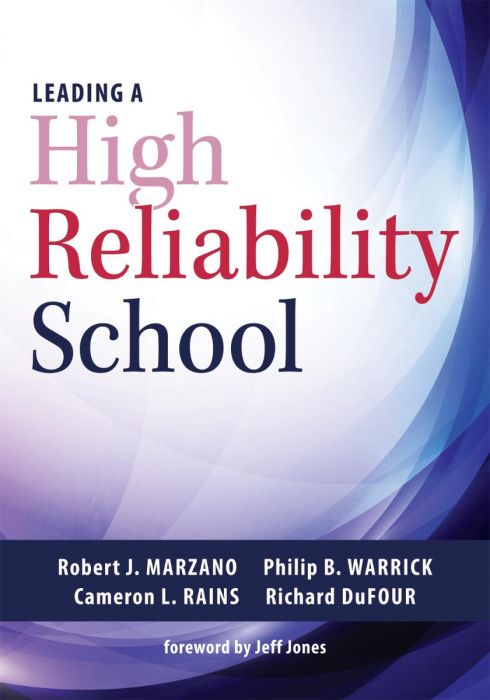
Leading a High Reliability School ![BESTSELLER]()
Learn how and why High Reliability Schools use interdependent systems of operation and the PLC at Work® process to establish and maintain school effectiveness.
Experience the convenience of eBooks! Access your eBooks anytime, anywhere on any desktop, Android, or iOS device through VitalSource. eBook purchases are limited to one eBook per title, per account. Please visit our FAQ for more information.
Use Data-Driven Instruction and Collaborative Teaching Strategies to Boost Academic Achievement
How do educators build High Reliability Schools (HRS) and boost academic achievement? By implementing interdependent systems of operation and performance assessment for student-centered learning. A critical commitment to becoming an HRS is the PLC at Work® process of collaborative learning and teaching. This user-friendly teaching resource focuses on: (1) a safe and collaborative culture, (2) effective teaching in every classroom, (3) a guaranteed and viable curriculum, (4) standards-referenced reporting of student progress (standards-based grading), and (5) a competency-based system.
Marzano, Warrick, Rains, and DuFour will help you:
- Increase school effectiveness through a focus on student-centered learning and the implementation of research-based leading indicators of operation.
- Monitor effective practices through the use of lagging indicators and quick data sources.
- Explore the three big ideas associated with the PLC at Work® process to implement student-centered learning, collaborative teaching strategies, and data-driven instruction.
- Engage in periodic reflection on effective school leadership and instructional coaching practices.
- Understand how to balance and achieve school and district goals using data to improve students' academic achievement and college- and career-readiness skills.
Related Topics
AssessmentCurriculumInstructionLeadershipProfessional Learning Communities at Work®School CultureSchool Improvement
Additional Information
“Leading a High Reliability School is a powerful and innovative new tool for instructional leaders. It is well grounded in relevant theory and high-quality research. But the book’s real treasure is the wealth of guidance and practical, actionable steps leaders can take to improve the quality of classroom instruction and make a measurable and substantial difference in student learning.”
“In Leading a High Reliability School, the authors present a blueprint for school leaders to effect positive change in student achievement. This easy-to-read guide provides leading indicators to enable leaders to measure their progress toward this goal. I recommend this book to anyone interested in improving student learning and achievement.”
“Leading a High Reliability School is a powerful and practical guide for achieving the leading indicators of a vision for success for all students. Authors Marzano, Warrick, Rains, and DuFour leave no stone unturned in pursuing how to create high reliability schools. The potential of this resource to impact learners and leadership in US schools is phenomenal!”
“Leading a High Reliability School builds on the school improvement framework provided in A Handbook for High Reliability Schools and helps leadership teams focus on the 'right work'—work that will improve student achievement. The book examines twenty-five research-based leading indicators in depth to help guide leaders in improving student achievement. In an easy-to-use format, it includes implementation steps and real examples from schools across the country, along with proficiency scales for every indicator. Marzano, Warrick, Rains, and DuFour identify the challenges leadership teams might face and specific strategies to address these challenges. It is a school leader’s guide to school improvement.”
When can I access my eBook? Your eBook will be accessible through VitalSource once your payment has been processed.*
*When using a check or purchase order, the order submitted online will not be processed until Solution Tree receives the check or a copy of the signed official purchase order. Your purchase order must note payment terms of net 30 days. We cannot process purchase orders that do not note these payment terms. Please submit all payments to [email protected].
How do I access my eBook?
To access your eBook:
- Create a free VitalSource account by visiting VitalSource.com. If you already have a VitalSource account, please log in to your account.
- Paste the redemption code that Solution Tree will email you in the “Redemption Code” field on VitalSource.com/Redeem. (Note: You can also access your redemption code within your Solution Tree account under the “eBook” section.)
- Click “Redeem.”
- Enjoy! Once your code is redeemed, your book will be added to your VitalSource Bookshelf and can be read anytime, anywhere.
What are the technical requirements for accessing the eBook? A VitalSource account is required. To sign up for your free account, please visit VitalSource.com.
What if I have trouble accessing my eBook? Please contact VitalSource by emailing [email protected] or by utilizing their Live Chat feature.
What are the shipping and handling costs? There are no shipping or handling costs associated with eBooks. For paperback and hardcover book purchases, standard shipping costs apply. Please visit the Product Orders page for more information on shipping and handling costs.
Can I purchase multiple copies of the same eBook? Bulk orders are not currently available through the website. Website purchases are limited to one eBook per title, per account. If you want to order multiple copies of an eBook, please contact customer support at [email protected].
What if I need to request a refund on my eBook order? RETURN POLICY: We are unable to accept returns or cancel previously placed eBook orders.

